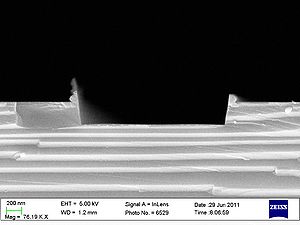Specific Process Knowledge/Etch/IBE⁄IBSD Ionfab 300/IBE Si etch: Difference between revisions
| Line 52: | Line 52: | ||
The silicon etch test was made as a preliminary test of the IBE system, to obtain a felling of the system capabilities and the different parameters influence on the etch outcome. A throughout characterization of the wafers was not carried out. However, the most important results are listed here. | The silicon etch test was made as a preliminary test of the IBE system, to obtain a felling of the system capabilities and the different parameters influence on the etch outcome. A throughout characterization of the wafers was not carried out. However, the most important results are listed here. | ||
The table list the best etch definition obtained. The IBE etcher should only be used for silicon etching, if you have a specific need that cannot be accommodated in a RIE tool. This could be excessive amount of metals on the surface or a layer of silicon in a stack of several layers that all must be etched. | The table list the best etch definition obtained. The IBE etcher should only be used for silicon etching, if you have a specific need that cannot be accommodated in a RIE tool. This could be excessive amount of metals on the surface or a layer of silicon in a stack of several layers that all must be etched. | ||
The corner definition is strongly dependent on both accelerator and beam voltage and of course the incident angle. However, no interactions between parameters seem to influence the angle outcome. The good corner definition will introduce hare ears at the resist edge. | The corner definition is strongly dependent on both accelerator and beam voltage and of course the incident angle. However, no interactions between parameters seem to influence the angle outcome. The good corner definition will introduce hare ears at the resist edge. This is best limited by use of thin resist layers slightly thicker than needed to mask for the duration of the etch. Be aware that the selectivity between silicon and resist is poor. | ||
===Contour plots of etch rate and corner angle=== | ===Contour plots of etch rate and corner angle=== | ||
Revision as of 14:10, 6 February 2013
Results for Si etching in the IBE
Made by Kristian Hagsted Rasmussen @ Nanotech in 2011 <br\>
Best recipe with respect to the etch profile and low redeposition:
| Parameter | Best Si etching recipe so fare |
|---|---|
| Neutalizer current [mA] | 450 |
| RF Power [W] | 1200 |
| Beam current [mA] | 400 |
| Beam voltage [V] | 600 |
| Beam accelerator voltage | 400 |
| Ar flow to neutralizer [sccm] | 6.0 |
| Ar flow to beam [sccm] | 6.0 |
| Rotation speed [rpm] | 20 |
| Stage angle [degrees] | 5 |
| Results | vvv |
| Etch rate [nm/min] | 17-18 |
Etch results
Some SEM profile images of the etched stacks
The silicon etch test was made as a preliminary test of the IBE system, to obtain a felling of the system capabilities and the different parameters influence on the etch outcome. A throughout characterization of the wafers was not carried out. However, the most important results are listed here. The table list the best etch definition obtained. The IBE etcher should only be used for silicon etching, if you have a specific need that cannot be accommodated in a RIE tool. This could be excessive amount of metals on the surface or a layer of silicon in a stack of several layers that all must be etched. The corner definition is strongly dependent on both accelerator and beam voltage and of course the incident angle. However, no interactions between parameters seem to influence the angle outcome. The good corner definition will introduce hare ears at the resist edge. This is best limited by use of thin resist layers slightly thicker than needed to mask for the duration of the etch. Be aware that the selectivity between silicon and resist is poor.




